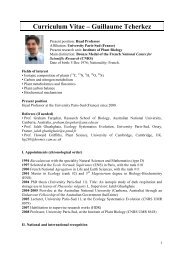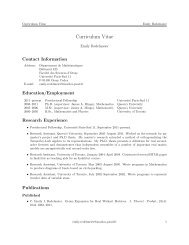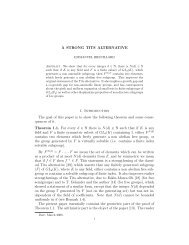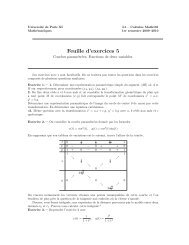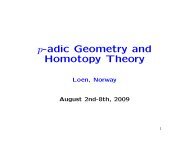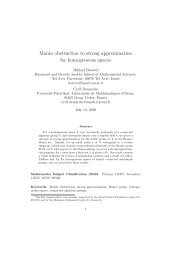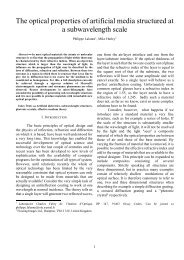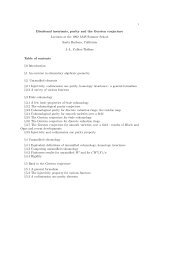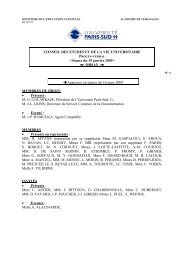Higgs – Induced Lepton Flavor Violation
Higgs – Induced Lepton Flavor Violation
Higgs – Induced Lepton Flavor Violation
Create successful ePaper yourself
Turn your PDF publications into a flip-book with our unique Google optimized e-Paper software.
<strong>Higgs</strong> <strong>–</strong> <strong>Induced</strong><br />
<strong>Lepton</strong> <strong>Flavor</strong> <strong>Violation</strong><br />
LPT - Orsay, 8/12/2011<br />
(based on arXiv:1111.1715<br />
with O.Lebedev, J.-h. Park)<br />
Andreas Goudelis<br />
DESY <strong>–</strong> Hamburg
Outline<br />
<br />
Introduction <strong>–</strong> fermion masses in the SM<br />
<br />
<br />
<br />
<br />
<br />
<strong>Higgs</strong> <strong>–</strong> dependent Yukawa couplings<br />
LFV constraints @ 1-loop and 2-loops<br />
Focus on dimension <strong>–</strong> 6 operators<br />
Reproducing the lepton mass hierarchy<br />
Conclusions
Introduction <strong>–</strong> the fermion masses in the SM<br />
3<br />
- In the Standard Model of particle physics, fermion masses are due to the interactions<br />
among fermion fields and the <strong>Higgs</strong> scalar doublet through the Yukawa prescription:<br />
L Y = Y u<br />
ij Q iL u c jH ¡ Y d<br />
ijQ iL d c jH c ¡ Y l<br />
ijL iL e c jH c + h:c:<br />
Some consequences :<br />
1) Mass and neutral current interaction terms can be diagonalized simultaneously. There<br />
are no FCNC's.<br />
2) In the quark sector there are charged FCC's (CKM matrix).<br />
3) There are no sources of <strong>Lepton</strong> <strong>Flavor</strong> <strong>Violation</strong> (LFV).<br />
- One important remark:<br />
In the SM it is possible to measure the Yukawa couplings. There is no way to predict<br />
their values : they are free parameters. In principle, since they are dimensionless<br />
quantities, one would expect them to be O(1).<br />
…but it turns out that the values of the Yukawa couplings span 6 orders of magnitude,<br />
kind of weird for terms seemingly of the same nature! In fact, the only O(1) Yukawa is<br />
the t-quark one...
4<br />
Introduction <strong>–</strong> efforts towards solving the problem<br />
Much effort has been devoted in the literature in order to explain the pattern of the<br />
fermion masses and mixings. Most typical models (not necessarily addressing exactly<br />
the same set of questions) are based on :<br />
- flavor symmetries (discrete or continuous) : impose some pattern for the Yukawa<br />
matrices.<br />
- extra dimensions : explain (or interpret) fermion mass hierarchy geometrically (e.g.<br />
localize fermions at different positions in the bulk).<br />
- GUTs : Depending on the specific construction, they can predict several parameters<br />
(occasionally some relations can even kill GUTs and might be unwanted!).<br />
- Froggatt <strong>–</strong> Nielsen mechanism : Assume some continuous U(1) symmetry,<br />
distinguishing the fermions. Break the symmetry through some “flavon” scalar S.<br />
Communicate the breaking to the fermions through different powers of some<br />
parameter ε = /M *<br />
(often ~O(0.22), the Cabibbo angle), with M *<br />
being associated<br />
with some new (usually) high physics scale. The hierarchies are then explained through<br />
the dependence on different powers of ε, which acts as a suppression factor.
HDYC : another option<br />
5<br />
→ What if the Yukawa couplings depend on the <strong>Higgs</strong> field itself?<br />
(Babu, Nandi - hep-ph/9907213, Giudice, Lebedev <strong>–</strong> arXiv:0804.1753)<br />
- Assume an effective theory valid below some new physics scale M in which the Yukawas<br />
are functions of the <strong>Higgs</strong> field. Then, they can generically be expanded as<br />
- If we assume that the coefficients vanish up to a generation-dependent order n, the<br />
effective Yukawa Lagrangian can be written as<br />
Where<br />
Y ij (H) =<br />
c n ij<br />
→ Then, upon EWSB the Yukawas receive contributions scaling as powers of<br />
1X<br />
n=0<br />
c (n)<br />
ij<br />
Y u;d;l<br />
ij<br />
(H) = c u;d;l<br />
ij<br />
µ H y H<br />
M 2 n<br />
L Y = Y u<br />
ij (H)Q Li u Rj H ¡ Y d<br />
ij(H)Q Li d Rj H c ¡ Y l<br />
ij(H)L Li e Rj H c + h:c:<br />
² = v 2 =M 2<br />
µ H y n<br />
u;d;l<br />
ij<br />
H<br />
M 2
6<br />
HDYC : some non-LFV consequences<br />
Assuming HDYC's has some interesting phenomenological consequences :<br />
- Drastic modification of the <strong>Higgs</strong> boson couplings. For specific choices we can have :<br />
¡ ¡ h ! b ¹ b ¢<br />
¡ ¡ h ! b ¹ b ¢ SM<br />
=<br />
¡ (h ! c¹c)<br />
= ¡ (h ! ¿ + ¿ ¡ )<br />
¡ (h ! c¹c) SM<br />
¡ (h ! ¿ + ¿ ¡ = 9;<br />
) SM<br />
¡ (h ! ¹ + ¹ ¡ )<br />
¡ (h ! ¹ + ¹ ¡ ) SM<br />
= 25<br />
- At low masses there can be a significant reduction of h → γγ<br />
- h → WW becomes dominant for larger masses than in the SM.<br />
- Appearance of flavor <strong>–</strong> violating <strong>Higgs</strong> decays.<br />
(e.g. Giudice, Lebedev <strong>–</strong> arXiv:0804.1753)<br />
- Tree-level FCNC effects are strongly model-dependent and potentially very<br />
dangerous! However, they can be suppressed so as to fulfill current experimental<br />
bounds (for a specific construction see, e.g. Giudice, Lebedev <strong>–</strong> arXiv:0804.1753).<br />
- New sources of CP <strong>–</strong> violation appear, which can find application in EW baryogenesis<br />
(Lebedev <strong>–</strong> arXiv:1011.2630).<br />
- The quark sector sets the new physics scale M at 1-2 TeV (reminds us of something?).
HDYC : the lepton sector<br />
7<br />
The suppression of the higher <strong>–</strong> dimensional operators by a new physics scale M could<br />
make us expect that its impact might be relatively small...<br />
However, we should note that the smallness of the lepton sector Yukawa couplings can<br />
make these contributions non-negligible!<br />
In particular, we shall see that the mass and interaction matrices are misaligned in<br />
flavor space, which can lead to <strong>Lepton</strong> <strong>Flavor</strong> <strong>Violation</strong> mediated by the SM <strong>Higgs</strong> boson.<br />
We shall take three steps :<br />
1) Compute model <strong>–</strong> independent bounds on the flavor violating couplings of the <strong>Higgs</strong><br />
boson.<br />
2) Examine the impact of dimension <strong>–</strong> 4 and 6 operators only : constrain NP scale,<br />
rotation angles.<br />
3) Examine Yukawa textures (patterns) which can reproduce the lepton mass hierarchy.
Bounds on <strong>Higgs</strong> couplings<br />
8<br />
The hll interaction Lagrangian is :<br />
¢L = ¡ y ij<br />
p<br />
2<br />
h ¹ l i P R l j<br />
+ h:c:<br />
which induces contributions to<br />
- flavor <strong>–</strong> changing three-body decays (e.g. μ → eee)
Bounds on <strong>Higgs</strong> couplings<br />
8<br />
The hll interaction Lagrangian is :<br />
¢L = ¡ y ij<br />
p<br />
2<br />
h ¹ l i P R l j<br />
+ h:c:<br />
which induces contributions to<br />
- flavor <strong>–</strong> changing three-body decays (e.g. μ → eee)<br />
- radiative flavor changing lepton decays (e.g. μ → eγ)<br />
- anomalous magnetic and dipole moments<br />
(+ Higher order<br />
corrections ...)
Bounds on <strong>Higgs</strong> couplings<br />
8<br />
The hll interaction Lagrangian is :<br />
¢L = ¡ y ij<br />
p<br />
2<br />
h ¹ l i P R l j<br />
+ h:c:<br />
which induces contributions to<br />
- flavor <strong>–</strong> changing three-body decays (e.g. μ → eee)<br />
- radiative flavor changing lepton decays (e.g. μ → eγ)<br />
What about them ???<br />
- anomalous magnetic and dipole moments<br />
(+ Higher order<br />
corrections ...)
Bounds on <strong>Higgs</strong> couplings<br />
8<br />
The hll interaction Lagrangian is :<br />
¢L = ¡ y ij<br />
p<br />
2<br />
h ¹ l i P R l j<br />
+ h:c:<br />
which induces contributions to<br />
- flavor <strong>–</strong> changing three-body decays (e.g. μ → eee)<br />
- radiative flavor changing lepton decays (e.g. μ → eγ)<br />
- anomalous magnetic and dipole moments
Bounds on <strong>Higgs</strong> couplings<br />
8<br />
The hll interaction Lagrangian is :<br />
¢L = ¡ y ij<br />
p<br />
2<br />
h ¹ l i P R l j<br />
+ h:c:<br />
which induces contributions to<br />
- flavor <strong>–</strong> changing three-body decays (e.g. μ → eee)<br />
- radiative flavor changing lepton decays (e.g. μ → eγ)<br />
- anomalous magnetic and dipole moments<br />
→ One can extract constraints on the y ij<br />
quantities in a model <strong>–</strong> independent manner!<br />
→ Most constraining turn out to be μ → eγ as well as d . e<br />
Some constraints also from μ → eee
Bounds on <strong>Higgs</strong> couplings : 1-loop<br />
9<br />
We'll focus on this<br />
observable present limit constraint constraint for<br />
y ij = y ji ; y ii = m i =v<br />
BR (¹ ! e°) 2:4 £ 10 ¡12 ³jy 31 y 23 j 2 + jy 32 y 13 j 2´1=4 < 7 £ 10<br />
¡4<br />
p<br />
jy13 y 23 j < 6 £ 10 ¡4<br />
BR (¿ ! ¹°) 4:4 £ 10<br />
³jy ¡8 33 j 2 (jy 32 j 2 + jy 23 j 2 )´1=4<br />
< 5 £ 10<br />
¡2<br />
jy 23 j < 2 £ 10 ¡1<br />
BR (¿ ! e°) 3:3 £ 10<br />
³jy ¡8 33 j 2 (jy 31 j 2 + jy 13 j 2 )´1=4<br />
< 5 £ 10<br />
¡2<br />
jy 13 j < 2 £ 10 ¡1<br />
BR (¹ ! eee) 1:0 £ 10<br />
³jy ¡12 11 j 2 (jy 21 j 2 + jy 12 j 2 )´1=4<br />
< 2 £ 10<br />
¡3<br />
jy 12 j < 1<br />
BR (¿ ! ¹¹¹) 2:1 £ 10<br />
³jy ¡8 22 j 2 (jy 23 j 2 + jy 32 j 2 )´1=4<br />
< 4 £ 10<br />
¡2<br />
jy 23 j < 1:7<br />
BR (¿ ! eee) 2:7 £ 10<br />
³jy ¡8 11 j 2 (jy 13 j 2 + jy 31 j 2 )´1=4<br />
< 4 £ 10<br />
¡2<br />
jy 13 j < O(10 2 )<br />
BR (¿ ! e¹¹) 2:7 £ 10<br />
³jy ¡8 22 j 2 (jy 13 j 2 + jy 31 j 2 )´1=4<br />
< 4 £ 10<br />
¡2<br />
jy 13 j < 1:7<br />
d e (e.cm) 1:1 £ 10<br />
q¯¯Im(y ¡27 31 y 13 )¯¯ < 2 £ 10<br />
q¯¯Im(y ¡4 13 2 )¯¯ < 2 £ 10 ¡4<br />
d ¹ (e.cm) 3:7 £ 10<br />
q¯¯Im(y ¡19 32 y 23 )¯¯ < 4:1<br />
q¯¯Im(y 23 2 )¯¯ < 4:1<br />
±a e 2:3 £ 10<br />
q¯¯Re(y ¡11 31 y 13 )¯¯ < 0:14<br />
q¯¯Re(y 13 2 )¯¯ < 0:14<br />
±a ¹ 40 £ 10<br />
q¯¯Re(y32 ¡10 y 23 )¯¯ < 0:13<br />
q¯¯Re(y<br />
2<br />
23 )¯¯ < 0:13<br />
And this
Bounds on <strong>Higgs</strong> couplings : 2-loops<br />
10<br />
observable<br />
BR (¹ ! e°)<br />
BR (¿ ! ¹°)<br />
BR (¿ ! e°)<br />
constraint<br />
³<br />
jy 12 j 2 + jy 21 j 2´1=2 < 6 £ 10<br />
¡6<br />
³<br />
jy 23 j 2 + jy 32 j 2´1=2 < 4 £ 10<br />
¡2<br />
³<br />
jy 13 j 2 + jy 31 j 2´1=2 < 3 £ 10<br />
¡2<br />
d e<br />
¯¯Im y 11¯¯ < 6 £ 10 ¡7<br />
d ¹<br />
¯¯Im y22¯¯ < O(10 2 )<br />
±a e<br />
¯¯Re y 11¯¯ < 0:27<br />
±a ¹<br />
¯¯Re y 22¯¯ < 0:21<br />
Particularly<br />
strong<br />
constraint !
Bounds on <strong>Higgs</strong> couplings : 2-loops<br />
10<br />
observable<br />
BR (¹ ! e°)<br />
BR (¿ ! ¹°)<br />
BR (¿ ! e°)<br />
constraint<br />
³<br />
jy 12 j 2 + jy 21 j 2´1=2 < 6 £ 10<br />
¡6<br />
³<br />
jy 23 j 2 + jy 32 j 2´1=2 < 4 £ 10<br />
¡2<br />
³<br />
jy 13 j 2 + jy 31 j 2´1=2 < 3 £ 10<br />
¡2<br />
d e<br />
¯¯Im y 11¯¯ < 6 £ 10 ¡7<br />
d ¹<br />
¯¯Im y22¯¯ < O(10 2 )<br />
±a e<br />
¯¯Re y 11¯¯ < 0:27<br />
±a ¹<br />
¯¯Re y 22¯¯ < 0:21<br />
Particularly<br />
strong<br />
constraint !<br />
(* NB : We also checked constraints coming from μ → e transitions in nuclei (Au, Ti)<br />
assuming SM couplings for quarks, bounds are quite weaker ~O(10 −³ - 10 −⁴).<br />
*)
Dimension <strong>–</strong> 6 operators : formalism<br />
11<br />
As a first step, we do not attempt explaining the lepton mass hierarchy. We instead<br />
focus on the potential result of including only dimension <strong>–</strong> 6 operators:<br />
µ<br />
¡¢L = H ¹ l Li e Rj Y (0)<br />
ij + Y (1) H y <br />
H<br />
ij<br />
M 2<br />
+ h:c:<br />
This gives us a lepton mass matrix:<br />
M ij = v<br />
µ<br />
Y (0)<br />
ij + Y (1) v 2 <br />
ij<br />
M 2<br />
and a matrix of couplings of the physical <strong>Higgs</strong> boson with leptons:<br />
Y ij = Y (0)<br />
ij + 3Y (1) v 2<br />
ij<br />
M 2<br />
Missalignment!<br />
The mass matrix M is diagonalized by two unitary matrices U L<br />
, U R<br />
:<br />
U y L M U R = diag(m e ; m ¹ ; m ¿ )<br />
→ Then, the interaction matrices<br />
Y ij<br />
should be transformed accordingly.
Dimension <strong>–</strong> 6 operators : scan strategy<br />
12<br />
We now wish to check whether the resulting LFV couplings are viable or not. To do so:<br />
1) We produce Yukawa textures through<br />
Y = U L<br />
1<br />
v diag(m e; m ¹ ; m ¿ ) U y R<br />
by scanning over the U matrices. These have the form:<br />
U L = V L ; U R = V R £ ; £ = diag(e iÁ 1<br />
; e iÁ 2<br />
; e iÁ 3<br />
)<br />
and comprise of 6 angles and 4 phases overall.<br />
2) Then, we split the Y matrices into dim-4 and dim-6 parts, by scanning over the dim-4<br />
matrix which is a general 3x3 complex matrix, providing an extra 9 complex parameters.<br />
We shall be checking two things:<br />
1) What is the relevant magnitude of the two contributions so that we get viable<br />
textures? What are the implications on the new physics scale?<br />
2) Which are the most essential angles in the whole story?
Dimension <strong>–</strong> 6 operators @ 1 loop<br />
13<br />
Dimension <strong>–</strong> 6 operators contributing up to 10% of Yukawas<br />
→ So, for arbitrary rotation angles the dim-6 operator contributions<br />
must be seen as rather small perturbations.<br />
¯<br />
¯Y (1)<br />
ij<br />
v 2<br />
M 2 ¯¯¯¯ < 0:1jY ij j £<br />
200 GeV<br />
m h
Dimension <strong>–</strong> 6 operators @ 1 loop<br />
Dimension <strong>–</strong> 6 operators contributing up to 10% of Yukawas<br />
Furthermore, we find two empirical relations for the scale M for two limiting cases:<br />
Y (1)<br />
ij » Y ij ) M > 500 GeV £<br />
Y (1)<br />
ij » 1 ) M > 200 TeV £<br />
13<br />
200 GeV<br />
m h<br />
200 GeV<br />
m h
Dimension <strong>–</strong> 6 operators @ 1 loop<br />
14<br />
Θ 13<br />
, Θ 23<br />
< 0.03<br />
→ So, for arbitrarily large dim <strong>–</strong> 6 contributions, we<br />
can only allow for small rotation angles.<br />
µ 13 ; µ 23 < 3 £ 10 ¡2 £ m h<br />
200 GeV
Dimension <strong>–</strong> 6 operators @ 2 loops<br />
15<br />
Dimension <strong>–</strong> 6 operators contributing up to 0.1% of Yukawas<br />
Extremely severe constraint @ 2 loops for the (1,2) <strong>–</strong> sector :<br />
¯<br />
¯Y (1)<br />
ij<br />
v 2<br />
M 2 ¯¯¯¯ < 10 ¡3 jY ij j
15<br />
Dimension <strong>–</strong> 6 operators @ 2 loops<br />
Dimension <strong>–</strong> 6 operators contributing up to 0.1% of Yukawas<br />
Or, seen differently :<br />
Y (1)<br />
ij » Y ij ! M > 5 TeV<br />
Y (1)<br />
ij » 1 ! M > 2000 TeV
Dimension <strong>–</strong> 6 operators @ 2 loops<br />
16<br />
Θ 13<br />
, Θ 23<br />
< 10 − ¹ , Θ 12<br />
< 10 − ² , φ's < 10 −¹<br />
→ The 13, 23 angles are more or less as previously, additional<br />
restrictions on the 12 mixing as well as the phases.<br />
The 2 <strong>–</strong> loop contributions induce new bounds on (previously unconstrained)<br />
parameters, and actually pretty tight ones!
Higher <strong>–</strong> dimensional operators : reminder<br />
17<br />
Now, we set off to try and reproduce the lepton mass hierarchy. Reminder of the initial<br />
hypothesis :<br />
L Y = Y u<br />
ij (H)Q Li u Rj H ¡ Y d<br />
ij(H)Q Li d Rj H c ¡ Y l<br />
ij(H)L Li e Rj H c + h:c:<br />
We consider the general expansion of the yukawas:<br />
Y ij (H) =<br />
1X<br />
n ij =0<br />
·(n ij)<br />
ij<br />
µ H y H<br />
M 2 nij<br />
- In principle an infinite series, where the<br />
lowest order terms should dominate for<br />
each Yukawa coupling.<br />
- Naturalness suggest that these<br />
coefficients should be O(1).<br />
- They could also be zero, if for<br />
instance some symmetry is at play<br />
in the high-energy theory.
Higher <strong>–</strong> dimensional operators : formalism<br />
18<br />
The idea is to indeed consider that the series' coefficients vanish up to some<br />
generation <strong>–</strong> dependent order n :<br />
Y ij (H) =<br />
1X<br />
n ij =0<br />
·(n ij)<br />
ij<br />
µ H y H<br />
M 2 nij<br />
O(1), vanishing up to some<br />
generation <strong>–</strong> dependent order<br />
→ Then, the mass hierarchy is generated by : ε = v²/M²
Higher <strong>–</strong> dimensional operators : formalism<br />
18<br />
The idea is to indeed consider that the series' coefficients vanish up to some<br />
generation <strong>–</strong> dependent order n :<br />
Y ij (H) =<br />
1X<br />
n ij =0<br />
·(n ij)<br />
ij<br />
µ H y H<br />
M 2 nij<br />
O(1), vanishing up to some<br />
generation <strong>–</strong> dependent order<br />
→ Then, the mass hierarchy is generated by : ε = v²/M²
Higher <strong>–</strong> dimensional operators : formalism<br />
18<br />
The idea is to indeed consider that the series' coefficients vanish up to some<br />
generation <strong>–</strong> dependent order n :<br />
Y ij (H) =<br />
1X<br />
n ij =0<br />
·(n ij)<br />
ij<br />
µ H y H<br />
M 2 nij<br />
O(1), vanishing up to some<br />
generation <strong>–</strong> dependent order<br />
→ Then, the mass hierarchy is generated by : ε = v²/M²
Higher <strong>–</strong> dimensional operators : some results<br />
19<br />
Factorizable<br />
Non - factorizable<br />
Remarks :<br />
- A 3-2-1 structure on the main diagonal seems natural for the e-μ-τ mass hierarchy.<br />
- The F-N mechanism kind of restricts textures. Especially if the 3-2-1 pattern is<br />
kept on the main diagonal, the choices are rather limited...
Higher <strong>–</strong> dimensional operators : results<br />
19<br />
Factorizable<br />
Non - factorizable<br />
→ Textures with strong hierarchies ( ↔ small intergenerational mixing)<br />
are strongly preferred!
Conclusions<br />
20<br />
- The framework of HDYC can explain the mass hierarchy of the fermion sector, which<br />
in the Standard Model finds no justification.<br />
- This assumption can result to important phenomenological consequences in <strong>Higgs</strong><br />
physics, CP <strong>–</strong> violation as well as <strong>Lepton</strong> <strong>Flavor</strong> <strong>Violation</strong> observables and EDMs.<br />
- We saw that it is possible to extract model-independent constraints on the couplings<br />
of the physical higgs boson with leptons from LFV and EDM/AMM observables. Of<br />
particular strength can be 2-loop contributions!<br />
- As a first step, we examined the impact of dimension-6 operators on lepton sector<br />
observables, finding that :<br />
1) If we do not restrict the rotation angles, small contributions from these operators<br />
are strongly favored.<br />
2) If we allow for significant contributions from dimension-6 operators, then small<br />
rotation angles are strongly preferred.<br />
- Then, we assumed that n-dimensional contributions vanish up to a generationdependent<br />
order n. In this way we can reproduce the lepton mass pattern. We saw<br />
that :<br />
1) “Factorizable” (Froggatt-Nielsen <strong>–</strong> inspired) Yukawa textures can be restrictive.<br />
2) Hierarchical textures, implying small intergenerational mixing, are preferred due to<br />
the strong constraints on LFV observables.
Merci !
Relevant LFV and EDM Lagrangians<br />
¢L = ¡ y ij<br />
p<br />
2<br />
h ¹ l i P R l j<br />
+ h:c:<br />
L e®1 = eL ij<br />
¹ li ¾ ¹º F ¹º P L l j + h:c:<br />
L e®2 = e ReL ii<br />
¹ li ¾ ¹º F ¹º l i ¡ ie ImL ii<br />
¹ li ¾ ¹º F ¹º ° 5 l i + h:c:<br />
Where :<br />
L ij =<br />
y¤ 3iy ¤ j3<br />
64¼ 2 m 2 h<br />
m ¿ ln m2 ¿<br />
m 2 h
Observables @ 1-loop<br />
¢L = ¡ y ij<br />
p<br />
2<br />
h ¹ l i P R l j<br />
+ h:c:<br />
BR(l j ! l i °) = BR(l j ! l i º j ¹º i ) £ 192¼3 ®<br />
G 2 F m2 j<br />
¡<br />
jLij j 2 + jL ji j 2¢<br />
BR(l j ! l i l k l + k ) = BR(l j ! l i º j ¹º i ) £ (4 ¡ ± ik)<br />
256G 2 F m4 h<br />
jy kk j 2¡ jy ij j 2 + jy ji j 2¢<br />
j±a ¹ j = 4m ¹¯¯ReL 22¯¯ ;<br />
jd i j = 2e¯¯ImL ii¯¯<br />
L ij =<br />
y¤ 3iy ¤ j3<br />
64¼ 2 m 2 h<br />
m ¿ ln m2 ¿<br />
m 2 h
Observables @ 2-loops<br />
¢L = ¡ y ij<br />
p<br />
2<br />
h ¹ l i P R l j<br />
+ h:c:<br />
BR(l j ! l i °) = BR(l j ! l i º j ¹º i ) £ 8®3 v 2<br />
3¼ 3 m 2 j<br />
f 2 (z) ¡ jy ij j 2 + jy ji j 2¢<br />
f(z) = 1 2 z Z 1<br />
0<br />
dx<br />
1 ¡ 2x(1 ¡ x)<br />
x(1 ¡ x) ¡ z<br />
ln<br />
x(1 ¡ x)<br />
z<br />
j±a ¹ j = 4m ¹¯¯ReL22¯¯ ;<br />
jd i j = 2e¯¯ImL ii¯¯<br />
L ii = ®<br />
24v¼ 3 f(z) y¤ ii
The Barr <strong>–</strong> Zee contributions<br />
8<br />
This contribution has :<br />
- 1 loop suppression factor<br />
- 1 gauge coupling (not so small)<br />
- 1 helicity suppression<br />
- 2 lepton Yukawas (VERY small !!!)<br />
This contribution has :<br />
- 2 loop suppression factors<br />
- One t-quark Yukawa ( O(1) )<br />
- 3 gauge couplings (not so small)<br />
- No helicity suppression<br />
- 1 lepton Yukawa
More examples @ 1 loop<br />
Dim-6 contributing up to<br />
50% of the mass matrix<br />
Θ 13<br />
, Θ 23<br />
< 0.1<br />
Inclusion of the 2-loop contributions completely kills all viable models !
Comparison to Froggatt <strong>–</strong> Nielsen mechanism :<br />
Q : Doesn't this thing remind a lot of the Froggatt <strong>–</strong> Nielsen mechanism ?<br />
A : Yes, but there are three important differences:<br />
1) The NP scale M is, in our setup, around the TeV scale unlike in the F-N mechanism<br />
where it is usually associated with some really high scale.<br />
2) The expansion parameter is quite smaller ( here chosen O(1/60) ) than in F-N<br />
constructions ( typicall O(0.22) ).<br />
3) There is no “flavon” field : H † H doesn't carry quantum numbers.<br />
(different situation in SUSY models, see discussion in arXiv:0804.1753)



